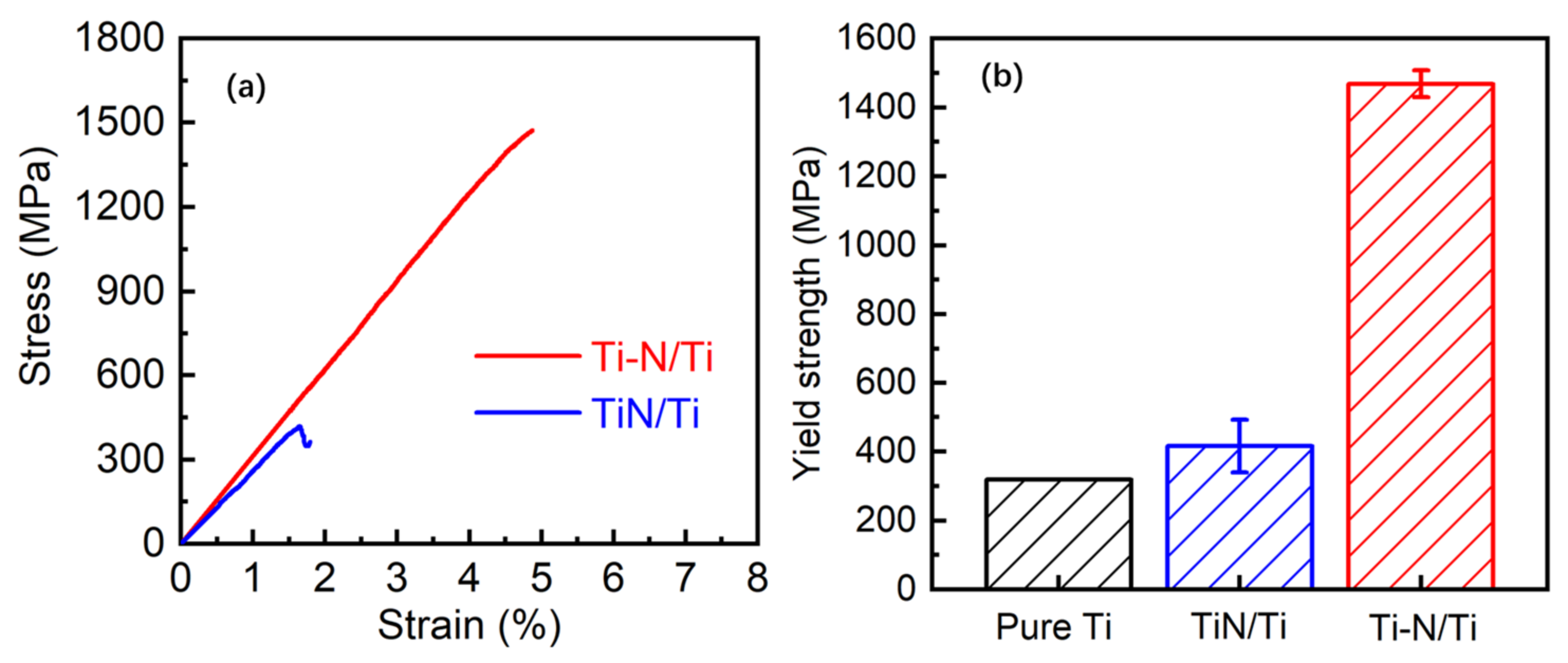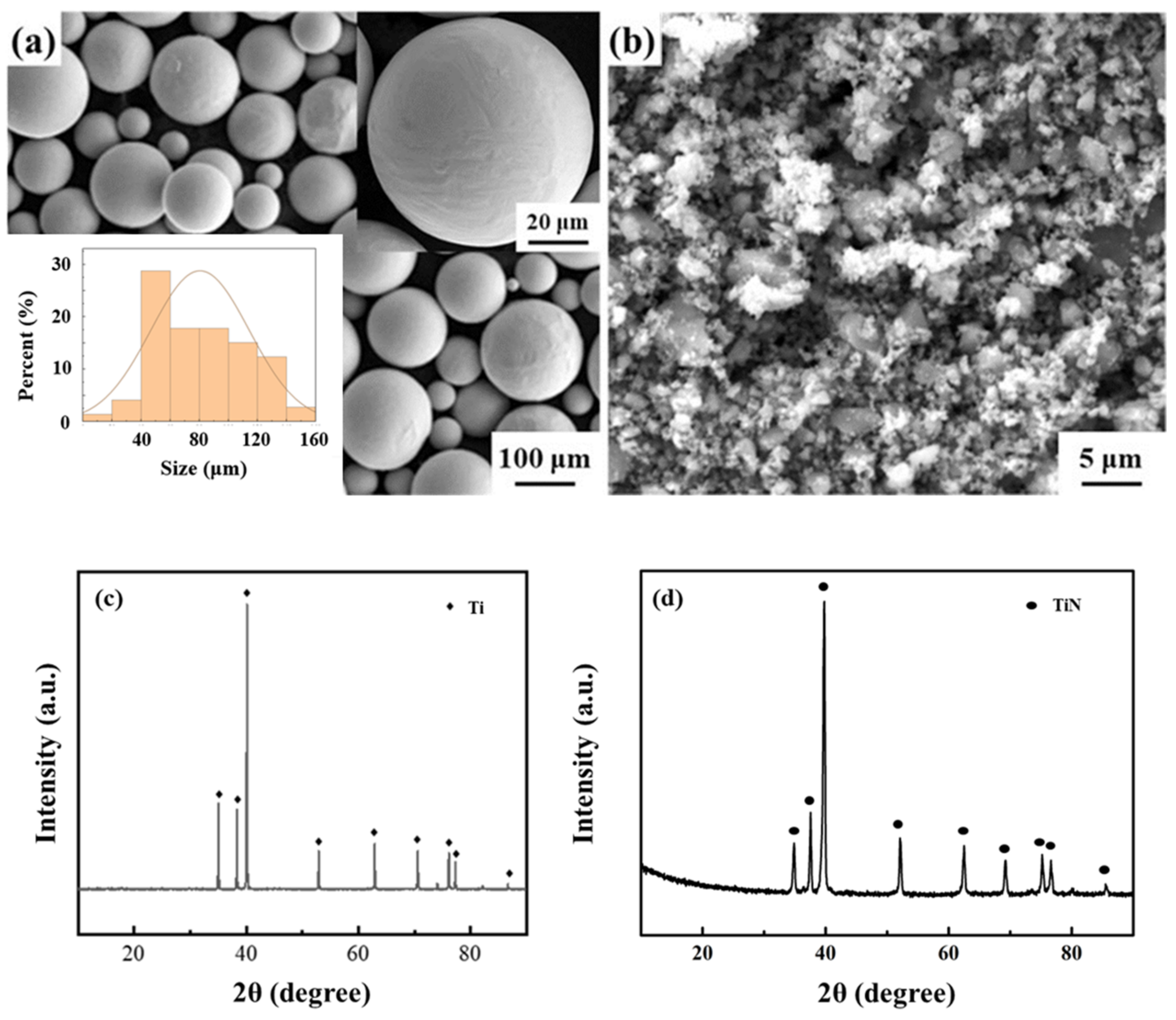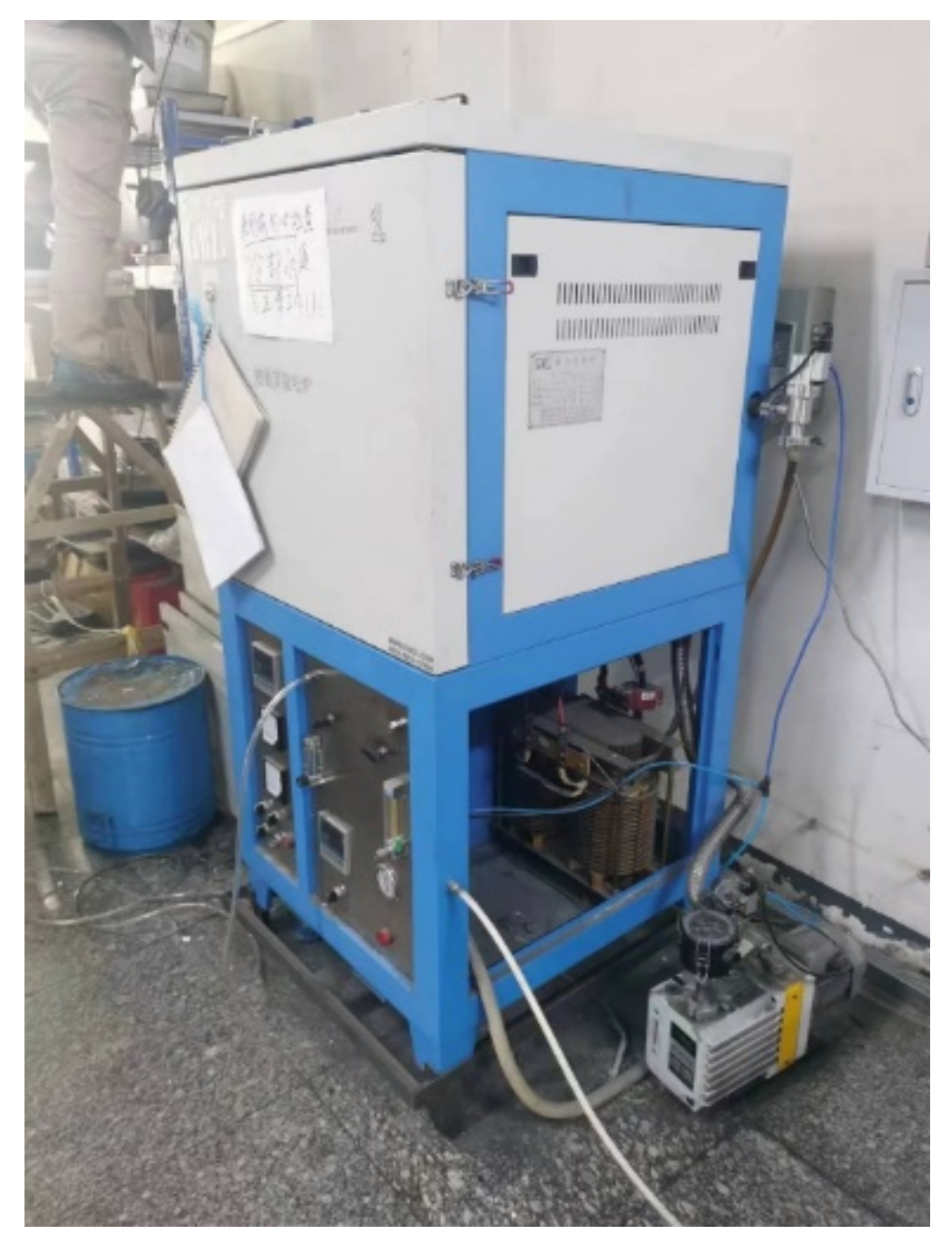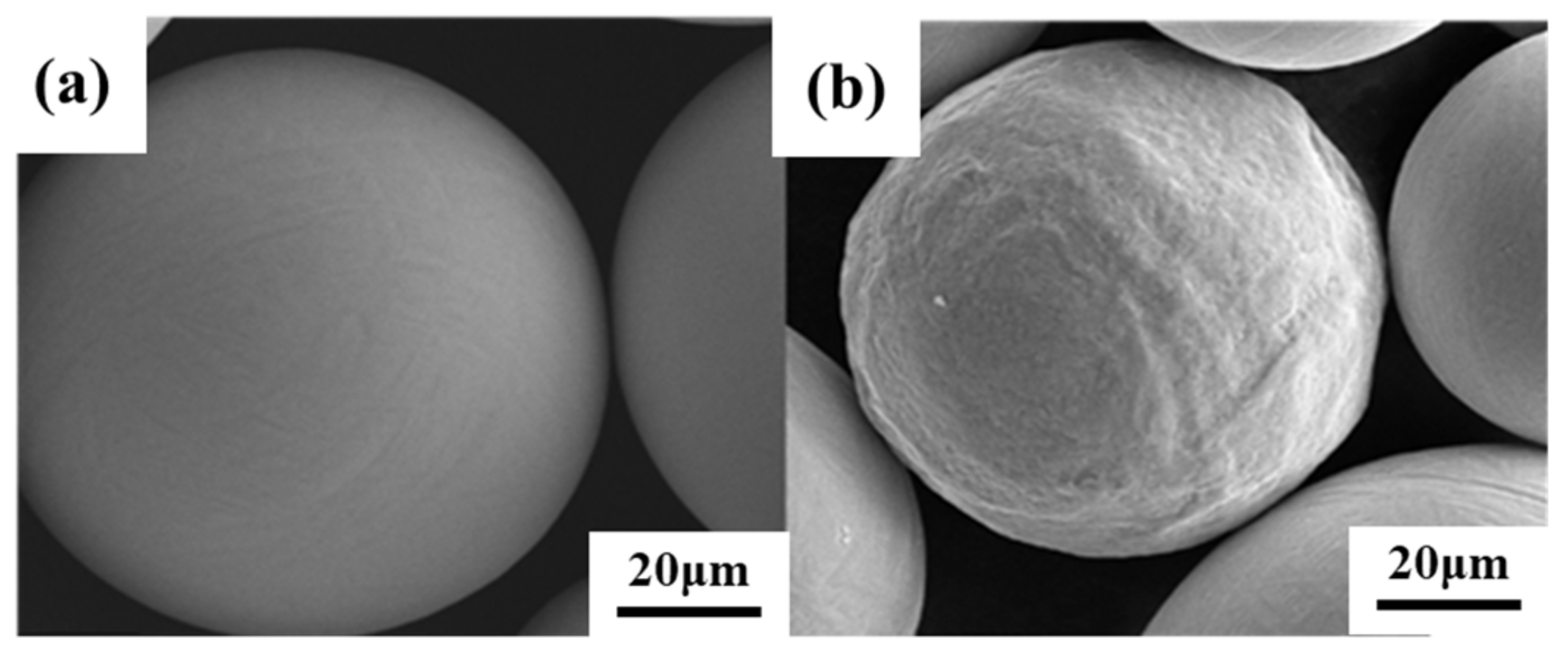Study on the Preparation of Network Ti-N/Ti Composites by Nitridation of Ti Powders
Abstract
:1. Introduction
2. Materials and Methods
2.1. Raw Materials
2.2. Preparation of Ti-Based Composites
2.3. Microstructure Characterization of Ti-Based Composites
2.4. Performance Tests of Ti-Based Composites
- λ—thermal conductivity, W/(m·K),
- k—thermal diffusion coefficient, m2/s,
- ρ—density of composite, kg/m3,
- C—specific heat capacity, J/(kg·K).
3. Result and Discussion
3.1. Microstructure Characterization of TiN and Ti Mixed Powders Prepared by Ball Milling and In-Situ Nitriding
3.2. Microstructure of Ti-Based Composites with a Network-TiN
3.3. The Effect of Network TiN on the Mechanical Properties of Composites
3.3.1. Mechanical Property

3.3.2. Hardness
3.3.3. Thermal Conductivity
4. Conclusions
Author Contributions
Funding
Institutional Review Board Statement
Informed Consent Statement
Data Availability Statement
Conflicts of Interest
References
- Huang, L.; An, Q.; Geng, L.; Wang, S.; Jiang, S.; Cui, X.; Zhang, R.; Sun, F.; Jiao, Y.; Chen, X.; et al. Multiscale Architecture and Superior High-Temperature Performance of Discontinuously Reinforced Titanium Matrix Composites. Adv. Mater. 2020, 33, e2000688. [Google Scholar] [CrossRef] [PubMed]
- Dong, L.L.; Lu, J.W.; Fu, Y.Q.; Huo, W.T.; Liu, Y.; Li, D.D.; Zhang, Y.S. Carbonaceous nanomaterial reinforced Ti-6Al-4V matrix composites: Properties, interfacial structures and strengthening mechanisms. Carbon 2020, 164, 272–286. [Google Scholar] [CrossRef]
- Zhao, Z.; Bai, P.; Du, W.; Liu, B.; Pan, D.; Das, R.; Liu, C.; Guo, Z. An overview of graphene and its derivatives reinforced metal matrix composites: Preparation, properties and applications. Carbon 2020, 170, 302–326. [Google Scholar] [CrossRef]
- Zhou, Y.; Yang, F.; Chen, C.; Shao, Y.; Lu, B.; Sui, Y.; Guo, Z. Mechanical property and microstructure of in-situ TiB/Ti composites via vacuum sintering and hot rolling. J. Alloys Compd. 2022, 911, 165042. [Google Scholar] [CrossRef]
- Xiong, N.; Bao, R.; Yi, J.; Fang, D.; Tao, J.; Liu, Y. CNTs/Cu-Ti composites fabrication through the synergistic reinforcement of CNTs and in situ generated nano-TiC particles. J. Alloys Compd. 2019, 770, 204–213. [Google Scholar] [CrossRef]
- Ren, L.; Xiao, W.L.; Kent, D.; Wan, M.; Ma, C.L.; Zhou, L. Simultaneously enhanced strength and ductility in a metastable beta-Ti alloy by stress-induced hierarchical twin structure. Scr. Mater. 2020, 184, 6–11. [Google Scholar] [CrossRef]
- Zhang, N.; Ju, B.; Deng, T.; Fu, S.; Duan, C.; Song, Y.; Jiang, Y.; Shen, Q.; Yao, C.; Liu, M.; et al. Effect of Volume Fraction of Reinforcement on Microstructure and Mechanical Properties of In Situ (Ti, Nb)B/Ti(2)AlNb Composites with Tailored Three-Dimensional Network Architecture. Materials 2022, 15, 9070. [Google Scholar] [CrossRef]
- Han, C.; Babicheva, R.; Chua, J.D.Q.; Ramamurty, U.; Tor, S.B.; Sun, C.-N.; Zhou, K. Microstructure and mechanical properties of (TiB+TiC)/Ti composites fabricated in situ via selective laser melting of Ti and B4C powders. Addit. Manuf. 2020, 36, 101466. [Google Scholar] [CrossRef]
- Hayat, M.D.; Singh, H.; He, Z.; Cao, P. Titanium metal matrix composites: An overview. Compos. Part A Appl. Sci. Manuf. 2019, 121, 418–438. [Google Scholar] [CrossRef]
- Xi, L.; Ding, K.; Gu, D.; Guo, S.; Cao, M.; Zhuang, J.; Lin, K.; Okulov, I.; Sarac, B.; Eckert, J.; et al. Interfacial structure and wear properties of selective laser melted Ti/(TiC+TiN) composites with high content of reinforcements. J. Alloys Compd. 2021, 870, 159436. [Google Scholar] [CrossRef]
- Li, C.; Lv, X.; Wu, X.; Chen, J.; Liu, X.; Pang, L. Nano-sized TiN-reinforced composites: Fabrication, microstructure, and mechanical properties. J. Mater. Res. 2019, 34, 2582–2589. [Google Scholar] [CrossRef]
- Cui, Z.D.; Zhu, S.L.; Man, H.C.; Yang, X.J. Microstructure and wear performance of gradient Ti/TiN metal matrix composite coating synthesized using a gas nitriding technology. Surf. Coat. Technol. 2005, 190, 309–313. [Google Scholar] [CrossRef]
- Morsi, K. Review: Titanium–titanium boride composites. J. Mater. Sci. 2019, 54, 6753–6771. [Google Scholar]
- Zhang, X.; Xu, Y.; Wang, M.; Liu, E.; Zhao, N.; Shi, C.; Lin, D.; Zhu, F.; He, C. A powder-metallurgy-based strategy toward three-dimensional graphene-like network for reinforcing copper matrix composites. Nat. Commun. 2020, 11, 2775. [Google Scholar] [CrossRef] [PubMed]
- Chu, K.; Wang, X.-h.; Wang, F.; Li, Y.-b.; Huang, D.-j.; Liu, H.; Ma, W.-l.; Liu, F.-x.; Zhang, H. Largely enhanced thermal conductivity of graphene/copper composites with highly aligned graphene network. Carbon 2018, 127, 102–112. [Google Scholar]
- Ozerov, M.; Stepanov, N.; Zherebtsov, S. Wear resistance of Ti/TiB composites produced by spark plasma sintering. AIP Conf. Proc. 2017, 1909, 020164. [Google Scholar]
- Wang, H.; Zhang, H.M.; Cheng, X.W.; Liu, L.; Chang, S.; Mu, X.N.; Ge, Y.X. Microstructure and mechanical properties of GNPs and in-situ TiB hybrid reinforced Ti–6Al–4V matrix composites with 3D network architecture. Mater. Sci. Eng. A 2022, 854, 143536. [Google Scholar] [CrossRef]
- Zhang, N.; Sun, D.; Han, X.; Wang, Z.; Liu, H.; Wang, Z.; Yang, W.; Wu, G. Effect of spark plasma sintering temperatures on microstructure and mechanical properties of in-situ (La2O3+TiB)/Ti2AlNb composites with a tailored three-dimensional network architecture. Mater. Sci. Eng. A 2020, 772, 138769. [Google Scholar]
- Li, Z.; Kang, Q.; Wang, G.; Sui, X.; Liu, Y.; Luo, S. Microstructure evolution during hot-packed rolling and mechanical properties anisotropy of as-rolled network-structured TiBw/TA15 composites. Mater. Sci. Eng. A 2022, 849, 143518. [Google Scholar]
- Wang, S.; Huang, L.; Jiang, S.; Zhang, R.; Liu, B.; Sun, F.; An, Q.; Jiao, Y.; Geng, L. Microstructure evolution and tensile properties of as-rolled TiB/TA15 composites with network microstructure. Mater. Sci. Eng. A 2021, 804, 140783. [Google Scholar] [CrossRef]
- Wang, S.; An, Q.; Zhang, R.; Jiang, S.; Huang, L.; Chen, R.; Liu, B.; Jiao, Y.; Geng, L. Microstructure characteristics and enhanced properties of network-structured TiB/(TA15-Si) composites via rolling deformation at different temperatures. Mater. Sci. Eng. A 2022, 829, 142176. [Google Scholar] [CrossRef]
- Huang, L.J.; Geng, L.; Peng, H.X.; Kaveendran, B. High temperature tensile properties of in situ TiBw/Ti6Al4V composites with a novel network reinforcement architecture. Mater. Sci. Eng. A 2012, 534, 688–692. [Google Scholar] [CrossRef]
- Traxel, K.D.; Bandyopadhyay, A. Influence of in situ ceramic reinforcement towards tailoring titanium matrix composites using laser-based additive manufacturing. Addit. Manuf. 2020, 31, 101004. [Google Scholar] [CrossRef] [PubMed]
- de Rojas Candela, C.S.; Riquelme, A.; Rodrigo, P.; Rams, J. Carrying Gas Influence and Fabrication Parameters Impact in 3D Manufacturing of In Situ TiN-Ti Composites by Direct Laser Deposition. Met. Mater. Int. 2022, 29, 591–606. [Google Scholar] [CrossRef]
- Zhao, Y.; Zhang, T.; Chen, L.; Yu, T.; Sun, J.; Guan, C. Microstructure and mechanical properties of Ti–C–TiN-reinforced Ni204-based laser-cladding composite coating. Ceram. Int. 2021, 47, 5918–5928. [Google Scholar] [CrossRef]
- Grigoriev, S.; Vereschaka, A.; Milovich, F.; Tabakov, V.; Sitnikov, N.; Andreev, N.; Bublikov, J.; Sotova, C. Investigation of the properties of Ti-TiN-(Ti,Al,Nb,Zr)N composite coating and its efficiency in increasing wear resistance of metal cutting tools. Surf. Coat. Technol. 2021, 421, 127432. [Google Scholar] [CrossRef]
- Morton, P.A.; Taylor, H.C.; Murr, L.E.; Delgado, O.G.; Terrazas, C.A.; Wicker, R.B. In situ selective laser gas nitriding for composite TiN/Ti-6Al-4V fabrication via laser powder bed fusion. J. Mater. Sci. Technol. 2020, 45, 98–107. [Google Scholar] [CrossRef]
- Sahasrabudhe, H.; Soderlind, J.; Bandyopadhyay, A. Laser processing of in situ TiN/Ti composite coating on titanium. J. Mech. Behav. Biomed. Mater. 2016, 53, 239–249. [Google Scholar] [CrossRef]
- Xie, Y.; Meng, X.; Chang, Y.; Mao, D.; Yang, Y.; Xu, Y.; Wan, L.; Huang, Y. Ameliorating strength-ductility efficiency of graphene nanoplatelet-reinforced aluminum composites via deformation-driven metallurgy. Compos. Sci. Technol. 2022, 219, 109225. [Google Scholar] [CrossRef]
- Zhang, Y.S.; Hu, J.J.; Zhang, W.; Yu, S.; Yu, Z.T.; Zhao, Y.Q.; Zhang, L.C. Discontinuous core-shell structured Ti-25Nb-3Mo-3Zr-2Sn alloy with high strength and good plasticity. Mater. Charact. 2019, 147, 127–130. [Google Scholar] [CrossRef]
- Wu, G.; Yu, Z.; Jiang, L.; Zhou, C.; Deng, G.; Deng, X.; Xiao, Y. A novel method for preparing graphene nanosheets/Al composites by accumulative extrusion-bonding process. Carbon 2019, 152, 932–945. [Google Scholar] [CrossRef]
- Kang, P.; Zhao, Q.; Guo, S.; Xue, W.; Liu, H.; Chao, Z.; Jiang, L.; Wu, G. Optimisation of the spark plasma sintering process for high volume fraction SiCp/Al composites by orthogonal experimental design. Ceram. Int. 2021, 47, 3816–3825. [Google Scholar] [CrossRef]
- Zhang, X.; Shi, C.S.; Liu, E.Z.; He, F.; Ma, L.Y.; Li, Q.Y.; Li, J.J.; Bacsa, W.; Zhao, N.Q.; He, C.N. Achieving high strength and high ductility in metal matrix composites reinforced with a discontinuous three-dimensional graphene-like network. Nanoscale 2017, 9, 11929–11938. [Google Scholar] [CrossRef] [PubMed]
- Shang, C.; Liu, T.; Zhang, F.; Chen, F. Effect of Network Size on Mechanical Properties and Wear Resistance of Titanium/Nanodiamonds Nanocomposites with Network Architecture. Compos. Commun. 2020, 19, 74–81. [Google Scholar] [CrossRef]











Disclaimer/Publisher’s Note: The statements, opinions and data contained in all publications are solely those of the individual author(s) and contributor(s) and not of MDPI and/or the editor(s). MDPI and/or the editor(s) disclaim responsibility for any injury to people or property resulting from any ideas, methods, instructions or products referred to in the content. |
© 2023 by the authors. Licensee MDPI, Basel, Switzerland. This article is an open access article distributed under the terms and conditions of the Creative Commons Attribution (CC BY) license (https://creativecommons.org/licenses/by/4.0/).
Share and Cite
Xiu, Z.; Ju, B.; Zhan, J.; Chen, W.; Yin, A.; Zhu, X.; Wang, P.; Wu, P.; Yang, W. Study on the Preparation of Network Ti-N/Ti Composites by Nitridation of Ti Powders. Materials 2023, 16, 5259. https://doi.org/10.3390/ma16155259
Xiu Z, Ju B, Zhan J, Chen W, Yin A, Zhu X, Wang P, Wu P, Yang W. Study on the Preparation of Network Ti-N/Ti Composites by Nitridation of Ti Powders. Materials. 2023; 16(15):5259. https://doi.org/10.3390/ma16155259
Chicago/Turabian StyleXiu, Ziyang, Boyu Ju, Junhai Zhan, Weidi Chen, Aiping Yin, Xiaolin Zhu, Pengjun Wang, Ping Wu, and Wenshu Yang. 2023. "Study on the Preparation of Network Ti-N/Ti Composites by Nitridation of Ti Powders" Materials 16, no. 15: 5259. https://doi.org/10.3390/ma16155259





